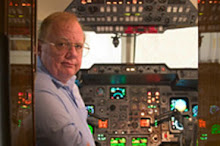NationAviation industry's drive for fuel economy spurs progress in cockpit technology
By: JANE WARDELL
Associated Press
07/22/10 5:55 AM PDTABOVE THE ENGLISH CHANNEL — Flying over the white cliffs of Dover, the two pilots of a Gulfstream 450 jet keep their eyes glued to a flight-deck display, ignoring the almost cloudless sky over the southern coast of England on their descent to a nearby runway.
Honeywell International Inc. pilot John Tuten and his co-pilot Paul Mrocka are testing what the U.S. aviation company calls the "cockpit of the future" — designed not just to improve safety but to boost fuel efficiency as well.
The new cockpit does that by aiding pilot vision, enabling a straighter, shorter path and less time burning fuel.
Instead of conventional screens filled with technical data that pilots have to interpret, the company's Synthetic Vision System converts the data into a three-dimensional "virtual" view of what's outside. The graphical representation of the surrounding terrain, nearby aircraft and runway approaches means that even in zero visibility — in thick cloud, complete darkness or fog — the pilot should be able to see where he's going just as easily as if flying conditions were perfect.
Combined with Honeywell's smart landing technology, which alerts crew if an approach is unstable or at a risky angle, that means faster landings and take-offs — getting planes in and out of the air quicker.
The goal is simple, says Carl Esposito, Honeywell vice president for marketing and product development.
"If you want to reduce emissions, what you need to do is fly less — so the faster you get to where you're going, the more direct you fly, the less emissions," Esposito says as the jet heads back to Farnborough airport, 30 miles (50 kilometers) west of central London.
Both the rising cost of fuel and demand for more environmentally-friendly flying are putting pressure on the aviation industry to come up with advances.
Aircraft makers and technology companies are battling each other to bring ever more efficiency to the market after pledging last year to cut emissions to 50 percent below 2005 levels by 2050.
The issue has become so urgent that organizers at this week's Farnborough International Airshow — the industry's premier event — devoted one of its five days to environmental issues.
And the star of the biennial show outside London was Boeing Co.'s 787 jetliner, a plane that the Chicago-based company says will use 20 percent less fuel when it enters service later this year, thanks to the lightweight composite materials that make up its frame instead of the traditional aluminium and titanium.
"Airlines are saying to us, we want less noise, we want the same speed, we want the range, but we want the environmental performance," Boeing's chief technology officer John J. Tracy said when he updated the industry on the long-delayed 787's progress this week.
In the next few years, both Boeing and arch rival Airbus expect to roll out new turbofan engines which promise 10-15 percent better performance, while Canadian plane maker Bombardier is marketing its C-Series single-aisle jet as a fuel-efficient alternative to the current duopoly's offerings.
The spotlight is now turning to additions to the plane's frame — the technology that goes aboard the lightweight aircraft to streamline efficiency gain even further.
Honeywell expects to roll out its cockpit technology, currently only available on business and executive jets, to commercial airlines over the next year.
"It's just one of a number of products offered by technology providers in the aviation industry, and with all the implications that cockpit technology has for safety and cost efficiency, it's no surprise that providers are fighting for a share of the marketplace," says Aviation Week analyst Ed Hazelwood.
"I think the new technology in all of the new aircraft helps the pilots a lot in terms of the amount of workload that they have to do when they're flying the aircraft," he adds. "So when the airplanes can give them the data and the information, and convert that data into information so that they can action on it, that's going to make it a lot easier for the pilot to fly the aircraft safely and efficiently."
The Honeywell technology also aids attempts to integrate air traffic control systems in Europe and end the current criss-crossing — and fuel burning — routes that planes must currently fly over the Continent. It could also reduce the amount of time they spend in so-called "stacking," or holding patterns as they wait to land. Analysts say those two measures could improve efficiency on some routes by 10-20 percent.
'); document.write('
'); }
To view this site, you need to have Flash Player 8.0 or later installed. Click here to get the latest Flash player.

- Mission bar fight turns bloody
- Pa. labor officials defend child work permits issued to Gosselin sextuplets on 'Kate Plus 8'
- Six cars torched at SFO long-term parking lot
- Unlucky lottery ticket thief wins hearing before judge
- Alioto-Pier cleared to run for re-election
- 18-year-old man pleads not guilty to murdering another teen for his gun
- 152 workers arrested, cited, released for protesting
- Chain store targets ’12 opening
- Robbery string continues on SF streets
- Hospital to cause traffic horror
'); document.write('
'); }
'); document.write('
'); }
In the pursuit of better fuel efficiency for business aircraft Honeywell is developing better cockpit displays for bizjets. Beyond biofuels aviation companies are seeking better immediate solutions.

